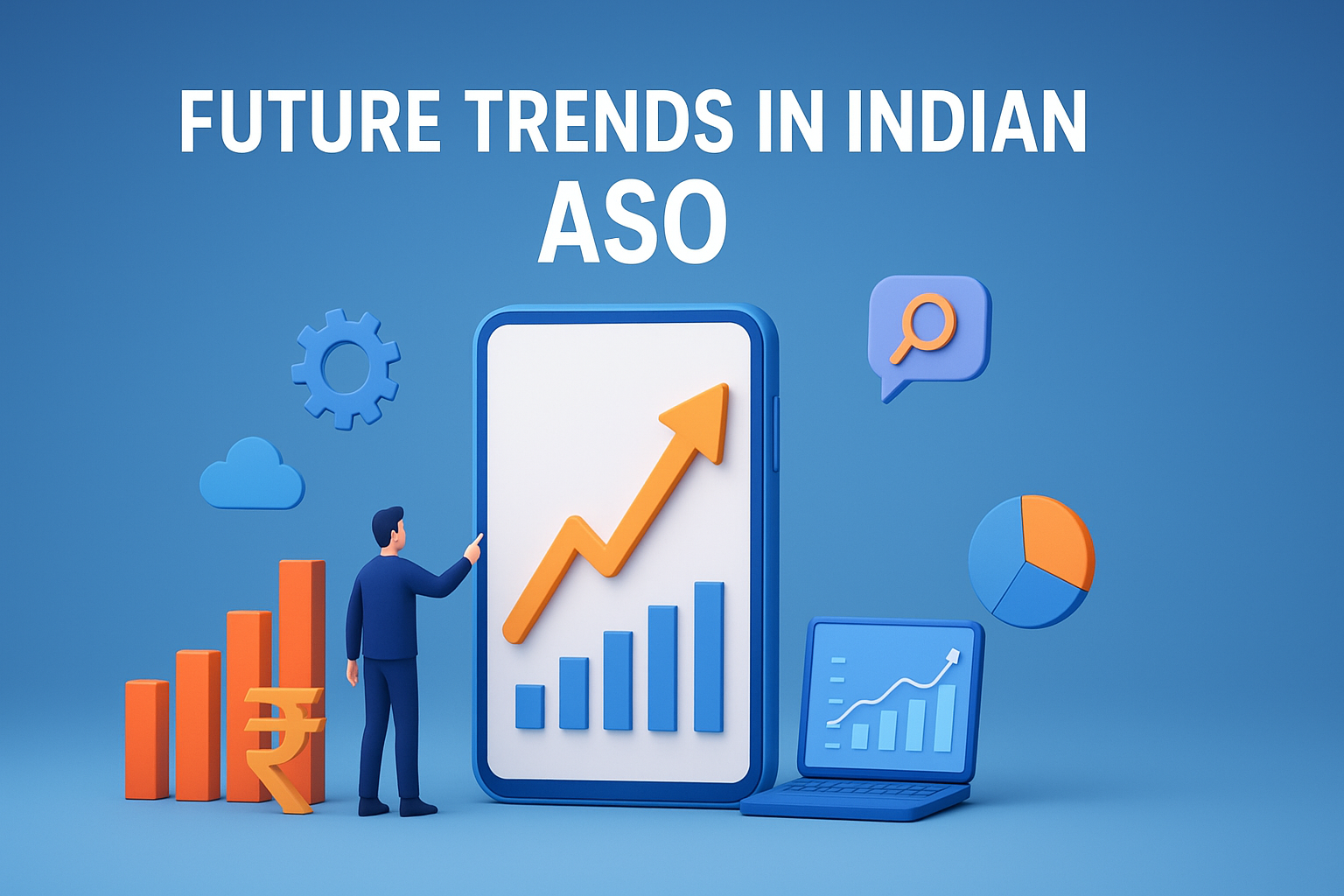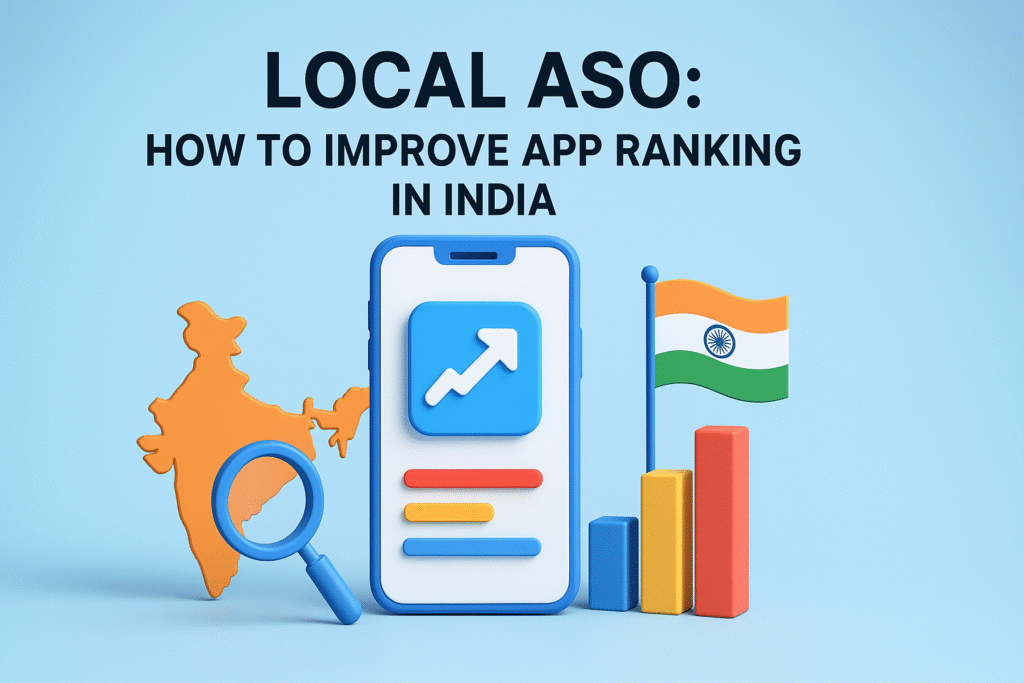The Indian app market is one of the fastest-growing in the world, with millions of daily downloads across Google Play and Apple’s App Store. However, this rapid expansion brings fierce competition. Simply publishing an app isn’t enough to gain visibility. You need to understand how to improve app store ranking in India using effective local ASO (App Store Optimization) techniques tailored for Indian users.
Local ASO ensures your app connects with regional audiences through relevant keywords, appealing visuals, and language preferences. It goes beyond global optimization — focusing on what Indian users search for, how they interact, and what influences their app download decisions. Let’s explore the most effective strategies to enhance your app’s ranking in India’s vibrant mobile landscape.
Table of Contents
Understanding App Store Optimization (ASO) in the Indian Context
ASO, or App Store Optimization, is similar to SEO but for mobile apps. It focuses on improving your app’s visibility within app stores, encouraging more organic downloads. However, Local ASO needs a localized approach.
The Indian market is unique, users come from different linguistic, cultural, and economic backgrounds. Unlike Western markets, a large portion of Indian users prefer apps in local languages and value culturally relatable content. Therefore, to succeed here, app optimization must consider India-specific factors such as local keywords, regional trends, and device preferences.
Understanding these distinctions helps you align your strategy with how Indian users discover and interact with apps.
Why Local ASO Matters for Indian Users?
India is a diverse nation with over 20 official languages and numerous regional dialects. This diversity directly affects app discovery and engagement patterns. Many users search using Hindi or regional phrases rather than English keywords.
Local ASO helps developers adapt their apps to these linguistic and cultural variations. It ensures that your app resonates with Indian audiences not just functionally, but emotionally and linguistically. By localizing metadata, visuals, and descriptions, you improve discoverability and user connection — two vital ranking factors.
In short, localization is no longer optional. It’s the foundation for mastering how to improve app store ranking in India.
Keyword Research — The Core of ASO
Finding Localized Keywords
Keyword research is the heart of Local ASO. For India, this means identifying search terms that Indian users actually use. Tools like Google Keyword Planner, AppTweak, and MobileAction can help find keywords specific to Indian trends.
For example, users may search in mixed English-Hindi formats (“best shayari app,” “free cricket score”) or with region-based intent (“Tamil movie songs app,” “Gujarati recipes”). Understanding these nuances helps you create metadata that mirrors real search behavior.
Using Keywords in Metadata
Once you’ve identified your localized keywords, integrate them naturally into your app’s:
- Title
- Subtitle or short description
- Long description
Ensure each placement feels organic. Avoid overstuffing — keyword repetition should enhance readability, not hinder it. A/B testing can help you determine which keywords perform best in the Indian market. This balanced keyword usage directly supports how to improve app store ranking in India by improving discoverability.
App Title and Description Optimization for Indian Users
Your app’s title and description are the first elements potential users see. In India, clarity and relatability matter. A good title is short, descriptive, and relevant. For example, combining a main feature with a keyword — such as “Music Player – Hindi Songs & Podcasts” — immediately signals purpose and relevance.
Descriptions should be conversational, using natural language to highlight benefits and functionality. When targeting Indian users, mention how the app meets their specific needs, such as support for local languages, Indian payment methods, or region-specific content.
Remember, the description is not just for algorithms but also for human readers. A well-written description increases conversion rates and strengthens trust.
Visual Optimization — Icons, Screenshots, and Videos
In India, visuals play a major role in influencing app downloads. Bright colors, clear typography, and culturally familiar visuals tend to perform well.
App Icons
Choose simple, distinctive icons that reflect your app’s core value. Avoid overcrowding the design.
Screenshots
Use high-quality screenshots that highlight real app features. Localize captions and use Indian imagery where appropriate.
Preview Videos
If possible, create preview videos featuring Indian voiceovers or subtitles. This adds familiarity and builds user connection.
Visual consistency across all materials enhances credibility and directly impacts conversion — a key step in how to improve Local ASO.
Boosting App Ratings and Reviews
Ratings and reviews strongly influence app store rankings. In India, users often read multiple reviews before installing an app.
Encourage satisfied users to leave positive feedback. This can be done by integrating review prompts after meaningful in-app experiences — for example, after completing a task or achieving a milestone.
Handle negative reviews professionally. Respond promptly, acknowledge issues, and highlight updates that resolve concerns. Consistent positive ratings improve credibility, while engagement with reviews shows transparency — both essential for ranking improvement.
Focusing on User Retention and Engagement
App installs alone don’t guarantee high rankings. Retention and engagement are equally crucial. If users uninstall shortly after downloading, it signals poor satisfaction to the algorithm.
Keep users engaged through:
- Regular content updates
- Push notifications with localized offers
- Smooth user experience and minimal app crashes
Retention data is a strong ranking signal. Apps with steady daily active users tend to rank higher. Improving engagement metrics is a long-term strategy for how to improve app store ranking in India that sustains visibility and trust.
App Localization Techniques for India
Localization goes beyond translation. It involves adapting your app’s overall experience to Indian users.
Language Localization
Support regional languages like Hindi, Tamil, Bengali, Marathi, and Telugu. Even offering a few major languages can significantly boost downloads.
Cultural and Visual Localization
Use visuals, icons, and references that feel familiar to Indian audiences. Avoid overly Western themes that might not connect with local users.
Payment and Pricing Localization
Enable popular Indian payment methods such as UPI, Paytm, and Net Banking. Pricing in Indian rupees makes your app more appealing and accessible.
Localization shows users that your app was built with them in mind — a critical factor in building loyalty and improving ranking.
Leveraging Social Proof and Influencer Marketing
Social proof plays a vital role in app success. Indian users often rely on word-of-mouth and social media recommendations before downloading apps.
Collaborating with micro-influencers, tech reviewers, or niche content creators helps build trust and boosts visibility. Encourage users to share experiences and screenshots on social media platforms.
The more your app is mentioned and shared online, the higher its credibility appears to app store algorithms. These social signals indirectly support how to improve app store ranking in India by driving consistent organic traffic.
Understanding Google Play Algorithm and Ranking Factors
To improve rankings, you need to understand what the algorithm values. For Google Play, key ranking factors include:
- Number of installs
- User retention rate
- Ratings and reviews
- App performance and stability
- Frequency of updates
Regular updates with performance improvements show the algorithm that your app is active and relevant. Focus on reducing app crashes, optimizing loading speed, and minimizing uninstall rates.
Consistency in these technical areas enhances your app’s ranking over time.
A/B Testing and Performance Tracking
A/B testing helps identify what works best for your Indian audience. You can test:
- Different titles and descriptions
- Visual layouts
- Keyword combinations
Use analytics tools like Firebase or App Annie to track conversion rates, downloads, and retention metrics.
Performance tracking reveals user behavior trends and helps refine strategies continuously. This iterative approach strengthens long-term ASO success.
Common ASO Mistakes to Avoid
Even with good intent, developers often make mistakes that hinder performance:
- Overstuffing keywords, making content unnatural.
- Using only English metadata for a multilingual market.
- Ignoring visuals and previews.
- Neglecting review management.
Avoiding these pitfalls ensures your app stands out in a saturated marketplace.
Future Trends in Indian ASO

India’s app ecosystem is evolving quickly. To stay ahead:
- Voice Search: With the rise of voice assistants, users are now searching apps using natural speech in regional languages.
- AI Personalization: App stores increasingly use AI to recommend apps based on behavior.
- 5G Expansion: Faster networks will drive higher app engagement, especially for streaming and gaming.
Adapting to these trends ensures your app remains visible and competitive.
Conclusion
Mastering local ASO is a continuous process. It involves understanding user behavior, cultural nuances, and evolving market trends.
To succeed, developers must focus on keyword relevance, localization, visuals, reviews, and consistent updates. These elements together determine how to improve app store ranking in India and sustain visibility in a crowded digital environment.
In essence, ASO for India isn’t just about algorithms — it’s about connecting with real users through local relevance, usability, and trust.
FAQs
Q1. What are the main factors that influence app store ranking in India?
A: App title, localized keywords, visuals, ratings, engagement, and user retention are the main ranking factors.
Q2. How often should I update my app for better ranking?
A: Updating every 4–6 weeks helps maintain activity and signals improvement to algorithms.
Q3. Do Indian language keywords really help?
A: Yes. Regional language keywords improve visibility for users who search in Hindi, Tamil, or other local languages.
Q4. What’s the difference between ASO and SEO for apps?
A: ASO targets visibility within app stores, while SEO drives traffic from search engines to app pages.
Q5. How long does it take to see ASO results in India?
A: Typically 4–8 weeks, depending on app quality, competition, and optimization consistency.



